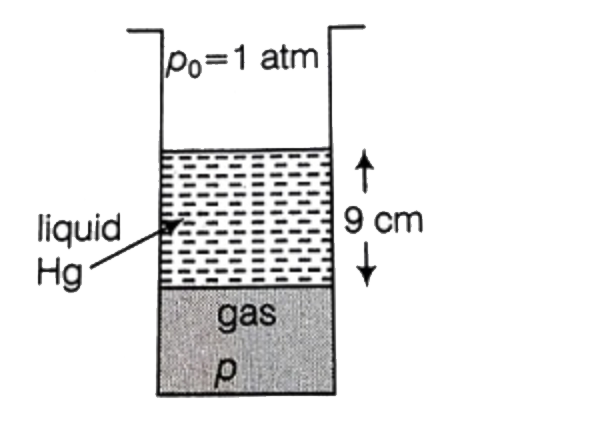A manometer reads the pressure of a gas in a enclosure as shown in figure(a) When some of the gas is removed by a pump, the manometer reads as in (b). The liquid used in the manometers is mercury and the atmospheric pressure is 76cm of mercury.

(i) Give the absolute and gauge pressure of the gas in the enclosure for cases (a) and (b) in units of cm of mercury .
(ii) How would the level change in case (b) if 13.6cm of water are poured into the right limb of the manometer?
The correct Answer is:A, B, C, D
(i) Absolute pressure in part (a)
=76cm of Hg+20cm of Hg
=96cm of Hg
Gauge pressure in part (a) =20cm of Hg
Absolute pressure in part (b)
=76cm of Hg−18cm of Hg=58cm of Hg
Gauge pressure in part (b) =−18cmofHg
(ii) 13.6cm of water is equivalent to 1cm of Hg. so the new level difference will become 19cm.
Topper's Solved these Questions
- FLUID MECHANICSBOOK - DC PANDEY ENGLISHCHAPTER - FLUID MECHANICSEXERCISE - Subjective Question
2 Videos
- FLUID MECHANICSBOOK - DC PANDEY ENGLISHCHAPTER - FLUID MECHANICSEXERCISE - Level 2 Single Correct
36 Videos
- FLUID MECHANICSBOOK - DC PANDEY ENGLISHCHAPTER - FLUID MECHANICSEXERCISE - Level 1 Single Correct
49 Videos
- EXPERIMENTSBOOK - DC PANDEY ENGLISHCHAPTER - EXPERIMENTSEXERCISE - Subjective
15 Videos
- GENERAL PHYSICSBOOK - DC PANDEY ENGLISHCHAPTER - GENERAL PHYSICSEXERCISE - INTEGER_TYPE
2 Videos
Similar Questions
Knowledge Check
A manometer reads the pressure of a gas in an enclosure as shown in the figure. The absolute and gauge pressure of the gas in cm of mercury is (take atmospheric pressure =76 cm of mercury)
A76,20B20,76C96,20D20,96
The pressure of real gas is less than the pressure of an ideal gas because of
View SolutionIn the given figure, atmospheric pressure p0=1 atm and mercury column length is 9 cm. Pressure p of the gas enclosed in the tube is

View SolutionThe pressure of a gas kept in an isothermal container is 200Kpa. If half the gas is removed from it, the pressure will be
View SolutionPressure versus density graph of an ideal gas is shown in figure

View SolutionThe length of a faulty barometer is 90 cm and there is a little air above the mercury. When the atmospheric pressure is 76cm of Hg it reads 74.8 cm. What will be the true atmospheric pressure if the reading on the barometer is 74.3cm ?

View SolutionDescribe the working of an open end manometer.
View SolutionThe pressure of moist gas is higher than pressure of dry gas.
View Solution
